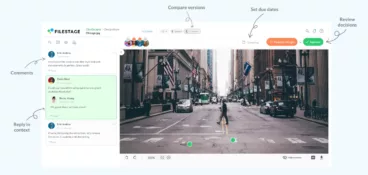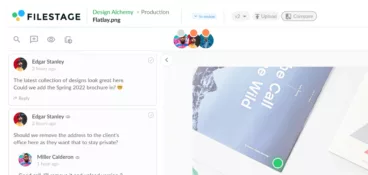According to Forbes, 49% of employees say that ineffective communication impacts their productivity. And in my experience, this is especially true when it comes to stakeholder communication.
Now I know that everyone’s different and we all have our quirks. But when it comes to communication during the review and approval process, there are a handful of characteristics that pop up again and again.
Six, to be precise.
So with a little help from my writer and designer friends, here’s a roundup of the six key characters in every review process – plus tips on how to handle them.
1. Fine Tooth Frankie – the one who comments on every single thing, even the stuff that clearly isn’t finished
OK, I’m going to be totally honest. This is me. (Not the guy in the GIF. I have far less hair.)
But I am a Fine Tooth Frankie. I’m the guy who goes over every detail of your copy, video, or design with a fine tooth comb. In fact, just last night I reviewed an article from a new freelance content writer using our document approval software. I added 54 comments. 😬

Source: Giphy
Let me explain myself.
As a fairly senior writer and content editor, I’m responsible for making sure everything we create aligns with our brand style and tone of voice. That means paying attention to teeny-tiny details like Oxford commas or the old hyphen vs. en dash conundrum. (What a sad little life.)
And I apply that same attention to detail to other types of content too. Here are a few examples:
- Ever-so-slightly misaligned components in a new web page design
- Inconsistent text heights in a new series of email mockups
- A one-pixel thick black line at the bottom of a product animation
The trouble is that, sometimes, the person sending me their work to review knows these things already. They haven’t perfected the alignment and font styles yet. They know there’s a glitch in the video render. But they don’t care about those details right now – they just want to know that they’re going in the right direction.
This causes two issues:
- I waste my time giving feedback on things that aren’t ready to review
- My teammates get annoyed at me for being, let’s be honest, such a pain in the ass
How to improve stakeholder communication with Fine Tooth Frankie: annotate your content
As a self-proclaimed Fine Tooth Frankie, I’m pretty well placed to help you set up an effective stakeholder communication plan for dealing with nitpickers like me.
So here’s my top tip! Annotate your content to tell your project stakeholders things like:
- What kind of feedback you’re looking for
- Which parts to focus on or ignore
- What you’re planning to do next
If you’re working on documents or articles, you can probably do this directly in Microsoft Word or Google Docs. But if you’re working on videos, designs, or even interactive HTML, you’ll need a more dedicated annotation tool like Filestage. You can see an example of how Filestage helps you do this with videos below.
2. Twelve Round Rocky – the one who sends one comment at a time, leading to lots of unnecessary review rounds
In the kingdom of stakeholders, Twelve Round Rocky is the arch-nemesis of Fine Tooth Frankie.
Instead of commenting on every detail, Rocky will point out one or two of the most obvious things that need changing. Then, when you share the next version, they’ll do the same thing again.
And again.
And again.
Until you’re getting change requests on double-digit version numbers wondering why, oh why, they didn’t mention these things on the first version so you could have saved all this time-wasting, mind-numbing, career-questioning back and forth.
And breathe …
To find out if I was alone in my experience of stakeholders like this, I reached out to fellow copywriter, Emma Cownley. And, as it turns out, I’m definitely not the only one.
“As a freelancer, multiple rounds of amendments aren’t great for business,” she says. “They force you to put other client work on the back burner while you sink more billable time into a project you’re not getting overtime for.”
Lucky for us, Cownley has some tips on how to deal with stakeholders like this.
How to improve stakeholder communication with Twelve Round Rocky: set a review round limit
This issue is especially common with key stakeholders. You know, the ones whose sign-off you really need. So it’s important to have a formal stakeholder communication plan that everyone’s onboard with.
“To help Twelve Round Rocky clients through the feedback process,” says Cownley, “I stipulate how many rounds of amendments are included with the project fee as part of my job proposal document.”
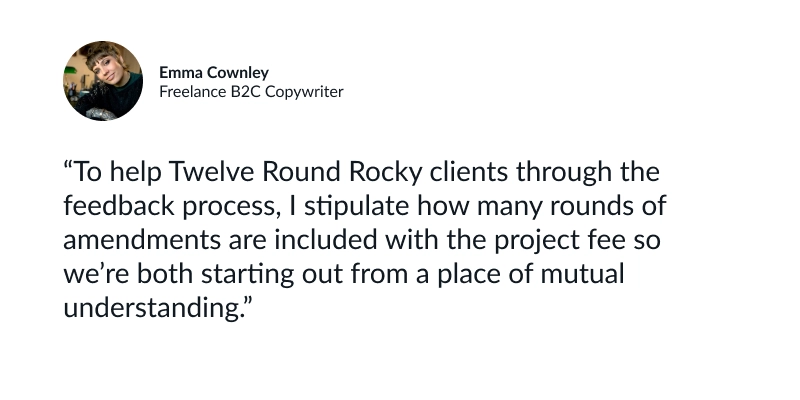
“I also mention it in the ‘process’ section of my proposals and on my freelance website. Then, I follow it up with a mention in my T&Cs, which are linked in my proposal, email footer, and on my website. There’s simply no missing it!”
“I also stipulate how much of the draft can be changed – 10% of the copy under the existing brief for the first round of edits and 5% for the final round of ‘tweaks’.”
“I ask the client to sign the proposal before we start work, so we’re both starting out from a place of mutual understanding. I include the option to pay for additional rounds of amendments starting at £55 an hour with a one-hour minimum. It’s worked a charm so far!”
By setting clear stakeholder communication requirements in advance, you can make sure there are no nasty surprises for your clients midway through the project. This is also a great way of building trust and improving your chances of project success.
3. Flip Flop Phoenix – the one who changes their mind or forgets all about their previous feedback
They say changing your mind is a sign of intelligence. And I absolutely, wholeheartedly, agree.
But when smart folks like Steve Jobs or Albert Einstein said this, they were talking about the ability to change your mind based on new facts or arguments. In other words, responding to objective data.
Which brings us to Flip Flop Phoenix. A Flip Flop Phoenix is the kind of person who gives subjective feedback on your work. And then, one or two versions later, they make a big fat U-turn on their previous comments, forcing you to bring old versions of your work back from the dead.

Source: Reddit
This can be particularly common at agencies, as freelance copywriter and Filestage contributor, Katie Garrett, explains.
“At my last agency, I worked with a really challenging client who would give really extensive feedback,” says Garrett. “We’d take it all on board, make the changes requested, and resubmit. All too often, he’d then come back and request for extra changes, which would in fact revert things back to what we’d originally written.”
This, of course, makes everything that happens between the first and last round of feedback feel like a complete waste of time.
How to improve stakeholder communication with Flip Flop Phoenix: remind them what they said
The most important thing to understand when you identify stakeholders like this is that they aren’t trying to be difficult.
Sometimes weeks can go by between reviewing one version and the next. And if your stakeholders are juggling multiple projects at once, they aren’t going to remember exactly what they said in each of your previous review rounds.
So what’s the solution?
“After this had happened a couple of times,” says Garrett, “we decided to always resubmit with tracked changes and all the original comments, so that he could see the original copy vs. the new.”
Annotating Word documents and tracking changes is a great option if you only have one or two people in your stakeholder groups. But if you have too many change requests, highlights, and strikeouts on your document, it can quickly become unreadable.
Filestage has a way around this – and it works for visual formats like videos and designs too! You can compare any two versions of a file side by side, including all the comments. And on top of that, you can also annotate new versions to remind stakeholders what you’ve changed based on their feedback.
Check out the demo video below to see it in action.
4. Essay Erin – the one who writes long-winded comments that take hours to unpick
Essay Erin is like Fine Tooth Frankie on acid. As well as having a keen eye for detail, they also go to extraordinary lengths to make sure you understand their feedback.
Literally.
This is the type of stakeholder who will drop multi-paragraph comments when reviewing documents. Or, when giving feedback on videos and designs, they’ll send War and Peace-style emails to roundup their feedback.
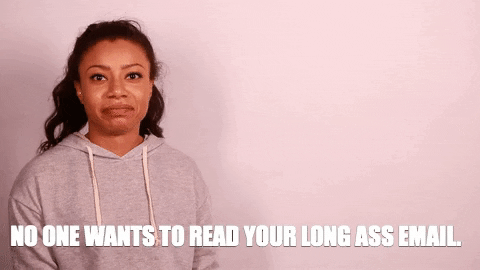
Source: Giphy
In one sense, you have to hand it to Essay Erin. They’re clearly passionate about your work and want to help make it the best it can be.
But, despite their best efforts, they can often cause two major issues:
- They spend longer giving feedback than most people, so it may take them a few extra days to review your work. In some cases, this can cause delays to your project because feedback didn’t come through fast enough.
- Other people in your stakeholder groups can’t be bothered to read all their comments, so you end up having to consolidate everything yourself. This lack of communication can quickly lead to conflicts which, yet again, you’re left sorting out.
How to improve stakeholder communication with Essay Erin: use a visual feedback tool
The main reason Essay Erin writes so much is because they feel the need to create context in their comments. And this is where visual feedback tools come to the rescue.
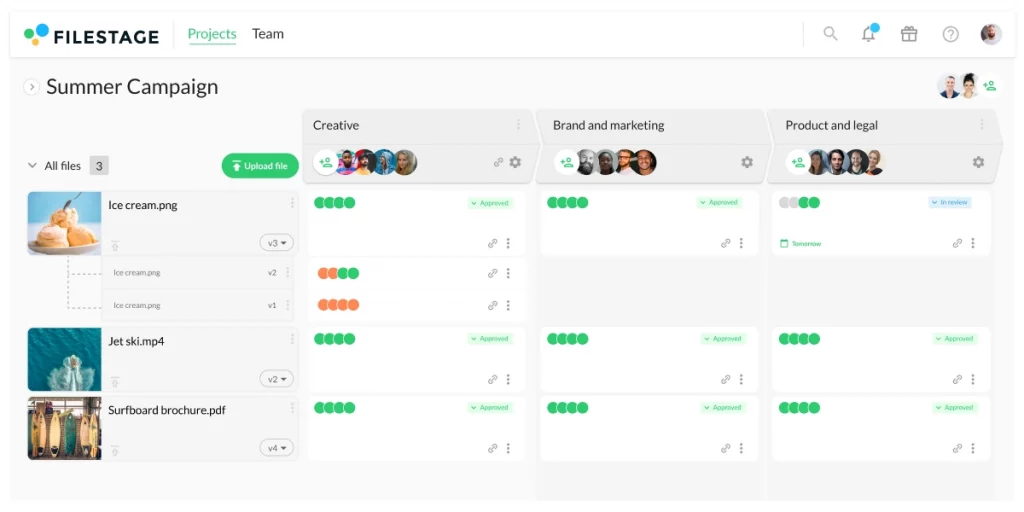
Instead of writing out video timecodes or describing which part of your design they’re talking about, they can just click on your content. From there, they can add:
- Comments
- Markers
- Annotations
- Highlights
- Strikeouts
- Attachments
And they can even tag you, other teammates, or stakeholders to discuss things in context.
By cutting out all the context-setting stuff upfront, Essay Erin will be able to give feedback faster. And, even better, you won’t have to waste time consolidating comments or ironing out conflicts. You can just crack on with the next version.
5. Blinkered Billy – the one who replies to the email chain without reading anyone else’s feedback
Have you ever got a piece of feedback from one of your stakeholders where you just think, hang on a minute, where has this come from? If the answer is yes, then it’s very likely that you found yourself dealing with a Blinkered Billy.
To understand how frustrating this type of feedback can be, I spoke to our in-house designer at Filestage, Adam Kelly.
“Here I am, pouring blood, sweat, and tears into the initial draft of a design for a new brand,” says Kelly. “I’ve detailed how it can be refined through subsequent drafts. By the time I reach the second, third, and fourth drafts, the response is overwhelmingly positive. About 30 emails have been circulating to discuss various aspects and iterations.”
“Then – bing! – an email lands in my inbox suggesting a color change. But this isn’t just any minor adjustment, it’s a radical alteration at the very foundation of the design. It becomes painfully clear that they haven’t been following the design process at all.”
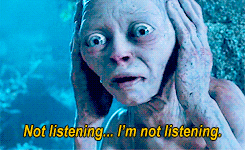
Source: Giphy
“This belated request set off a chain reaction of disputes within his company,” says Kelly, “culminating in them shouldering the cost for a bunch of extra iterations. And guess what? We stuck with the original design in the end.”
How to improve stakeholder communication with Blinkered Billy: make review rounds more transparent
If you want to improve your stakeholder relationships and avoid the possibility of one stakeholder totally derailing your project, you need to make your content reviews as transparent as possible.
One option here is to get together in the same room or have online meetings to discuss the work. This has the benefit of making sure anyone who needs to be involved is involved. And it also lets you iron out any contentious points on the fly.
But if you need a more remote- and asynchronous-friendly solution, you could try Filestage. This gives you an easy way to inform stakeholders when a new file is ready for them to review. And it gives them a collaborative space to annotate and comment on your work, whenever it works for them.
6. Forgetful Phil – the one who you constantly have to chase for feedback and approval
And how could we forget … Forgetful Phil!
“I recently worked with a client who was really hard to get hold of for feedback,” says freelance copywriter, Katie Garrett. “I’d submit the work, wait patiently for feedback, and end up having to send at least three chase-up emails before she’d get back to me.”

Source: Giphy
And this doesn’t just happen when dealing with clients. It can even be an issue when you’re in the same building. One of my old creative directors was always difficult to pin down, so account and project managers used to camp at his desk just to get him to look at something.
“Fortunately,” says Garrett, “it would often be then approved right away. But occasionally there would be amends that needed to be made. The problem was that, by that time, I was already knee-deep in work for other clients and struggled to find time to make those changes.”
How to improve stakeholder communication with Forgetful Phil: set due dates for feedback
The key to improving stakeholder engagement with a Forgetful Phil is understanding why they aren’t giving feedback.
In Garrett’s case, it was often because the client was happy and had no comments. “As a solution,” she says, “I had a conversation with her and we agreed that if I hadn’t received feedback by the end of each month, then I could count the copy as approved. This meant that I knew where I stood, and I could mark each project as approved at the end of each month.”
But, in other cases, key stakeholders have so much on their plate that they simply forget. In this scenario, you need a system for reminding different stakeholder groups to give feedback – and Filestage has just the thing!
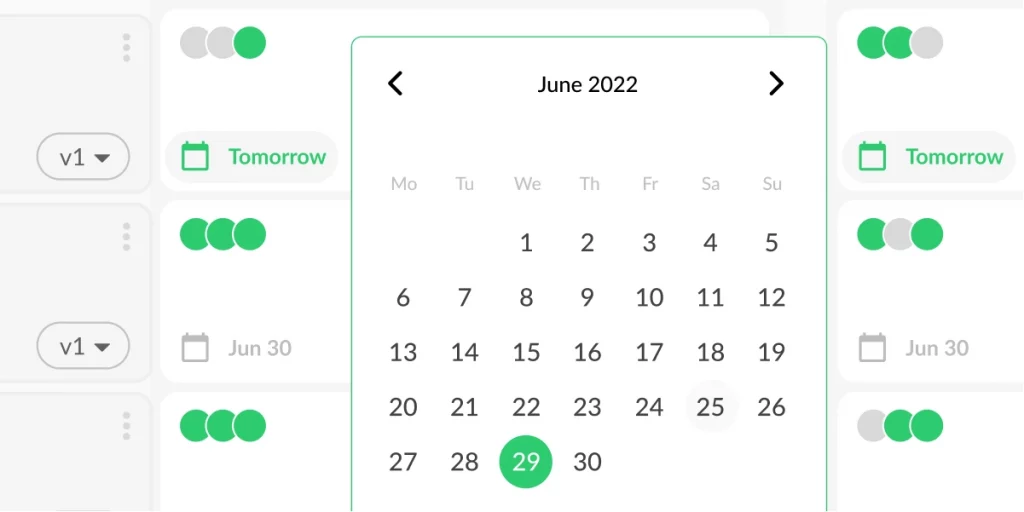
By setting a due date for your files and reviewers, you can trigger automated email or chat reminders as the deadline approaches. Your stakeholder groups will even have access to their own personalized “Awaiting my review” list.
Final thoughts
If you want to run your project successfully, you need to think about stakeholder engagement.
Stakeholder engagement refers to your processes for involving key stakeholders and decision makers in your project. By considering this upfront and thinking about the different characters you’ll be dealing with, you can form a strong stakeholder communications plan to keep things moving forward.
I hope this article has given you everything you need to level up your stakeholder management game. In the end, it all comes down to personalizing your approach so that you can get clear feedback to avoid the risk of mistakes or false advertising claims creeping into your work.
And if you want a better way to visualize your stakeholder groups during the approval process, start a free trial of Filestage. It gives you a project summary report of every approval, comment, and change request, so you have a clear overview of your project status in real time.





